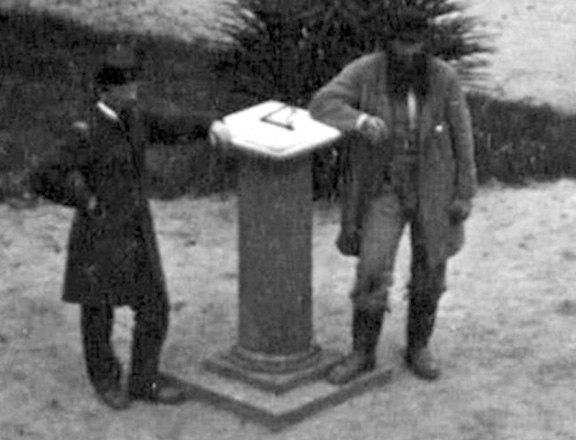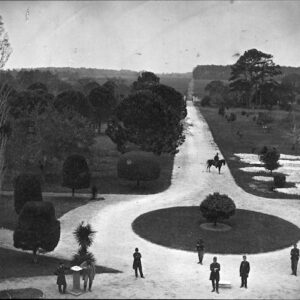Tag: sundial
 Wikipedia says: A sundial is a horological device that tells the time of day (in modern usage referred to as civil time) when there is sunlight by the apparent position of the Sun in the sky. In the narrowest sense of the word, it consists of a flat plate (the dial) and a gnomon, which casts a shadow onto the dial. As the Sun appears to move across the sky, the shadow aligns with different hour-lines, which are marked on the dial to indicate the time of day. The style is the time-telling edge of the gnomon, though a single point or nodus may be used. The gnomon casts a broad shadow; the shadow of the style shows the time. The gnomon may be a rod, wire, or elaborately decorated metal casting. The style must be parallel to the axis of the Earth’s rotation for the sundial to be accurate throughout the year. The style’s angle from horizontal is equal to the sundial’s geographical latitude.
Wikipedia says: A sundial is a horological device that tells the time of day (in modern usage referred to as civil time) when there is sunlight by the apparent position of the Sun in the sky. In the narrowest sense of the word, it consists of a flat plate (the dial) and a gnomon, which casts a shadow onto the dial. As the Sun appears to move across the sky, the shadow aligns with different hour-lines, which are marked on the dial to indicate the time of day. The style is the time-telling edge of the gnomon, though a single point or nodus may be used. The gnomon casts a broad shadow; the shadow of the style shows the time. The gnomon may be a rod, wire, or elaborately decorated metal casting. The style must be parallel to the axis of the Earth’s rotation for the sundial to be accurate throughout the year. The style’s angle from horizontal is equal to the sundial’s geographical latitude.
The term sundial can refer to any device that uses the Sun’s altitude or azimuth (or both) to show the time. Sundials are valued as decorative objects, metaphors, and objects of intrigue and mathematical study.
The passing of time can be observed by placing a stick in the sand or a nail in a board and placing markers at the edge of a shadow or outlining a shadow at intervals. It is common for inexpensive, mass-produced decorative sundials to have incorrectly aligned gnomons, shadow lengths, and hour-lines, which cannot be adjusted to tell correct time.
There are several different types of sundials. Some sundials use a shadow or the edge of a shadow while others use a line or spot of light to indicate the time.
The shadow-casting object, known as a gnomon, may be a long thin rod or other object with a sharp tip or a straight edge. Sundials employ many types of gnomon. The gnomon may be fixed or moved according to the season. It may be oriented vertically, horizontally, aligned with the Earth’s axis, or oriented in an altogether different direction determined by mathematics.
Given that sundials use light to indicate time, a line of light may be formed by allowing the Sun’s rays through a thin slit or focusing them through a cylindrical lens. A spot of light may be formed by allowing the Sun’s rays to pass through a small hole, window, oculus, or by reflecting them from a small circular mirror. A spot of light can be as small as a pinhole in a solargraph or as large as the oculus in the Pantheon.
Sundials also may use many types of surfaces to receive the light or shadow. Planes are the most common surface, but partial spheres, cylinders, cones and other shapes have been used for greater accuracy or beauty.
Sundials differ in their portability and their need for orientation. The installation of many dials requires knowing the local latitude, the precise vertical direction (e.g., by a level or plumb-bob), and the direction to true North. Portable dials are self-aligning: for example, it may have two dials that operate on different principles, such as a horizontal and analemmatic dial, mounted together on one plate. In these designs, their times agree only when the plate is aligned properly.
The earliest sundials known from the archaeological record are shadow clocks (1500 BC or BCE) from ancient Egyptian astronomy and Babylonian astronomy. Presumably, humans were telling time from shadow-lengths at an even earlier date, but this is hard to verify. In roughly 700 BC, the Old Testament describes a sundial—the “dial of Ahaz” mentioned in Isaiah 38:8 and 2 Kings 20:11. By 240 BC Eratosthenes had estimated the circumference of the world using an obelisk and a water well and a few centuries later Ptolemy had charted the latitude of cities using the angle of the sun. The people of Kush created sun dials through geometry. The Roman writer Vitruvius lists dials and shadow clocks known at that time in his De architectura. The Tower of Winds constructed in Athens included sundial and a water clock for telling time. A canonical sundial is one that indicates the canonical hours of liturgical acts. Such sundials were used from the 7th to the 14th centuries by the members of religious communities. The Italian astronomer Giovanni Padovani published a treatise on the sundial in 1570, in which he included instructions for the manufacture and laying out of mural (vertical) and horizontal sundials. Giuseppe Biancani’s Constructio instrumenti ad horologia solaria (c. 1620) discusses how to make a perfect sundial. They have been commonly used since the 16th century.
Showing the single result
